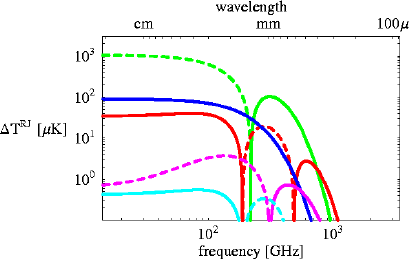|






| |
|
Sunyaev-Zel'dovich (SZ) effect in known clusters
|
|
|
|
|
|
As CMB photons travel from the surface of last scattering
to the observer, secondary anisotropies can arise due to the
interaction of the CMB photons with intervening matter.
Of particular interest is the S-Z
effect, which
occurs when CMB photons travel through a cluster of galaxies.
Approximately 10% of the total mass of rich clusters of galaxies
is in the form of hot (~ 108 K ) ionized plasma.
Compton scattering of CMB photons by electrons in this intra-cluster
plasma can result in an optical depth as high as 0.02, resulting in
a distortion of the CMB spectrum at the mK level.
There are multiple components of the S-Z effect which result from distinct
velocity components of
the scattering electrons. The thermal component
is due to
the thermal (random) velocities of the scattering electrons. The kinematic
component is due to the bulk velocity of the intra-cluster
gas with respect to the rest
frame of the CMB.
The spectral distortions
produced by components of the S-Z effect are shown here. |
|
|
|
|

Spectra of the Components of the S-Z Effect (from
J. Peterson). The Rayleigh-Jeans Temperature vs. frequency of different components of
the Sunyaev-Zel'dovich effect is plotted for a typical cluster of galaxies. In this simulation,
the gas has temperature T= 10
keV; peculiar velocity v = 1000 km
s-1 toward us; and
a Thompson optical depth of t = 0.01. Solid curves indicate increments in the
CMB
temperature, and the dashed curves decrements. These different components can be distinguished by
spectral shape using sufficiently sensitive millimeter- and submillimeter-wave detectors. From
top to bottom the components are
- the classical thermal S-Z effect ( t
T);
- the classical kinetic S-Z effect (t
v);
- relativistic corrections to (1) (t
T2);
- thermal corrections to (2) (vt
T);
- finite optical depth corrections (t
2T2).
By measuring the amplitude
of (1) and
(3), t
and T may be separately determined; the amplitude of
(2) additionally
gives v, although measurements of this amplitude will be convolved with superposed primary
CMB anisotropy, which has the same signature. This uncertainty can be removed by measuring
the amplitude of (4). Accurate arcminute-resolution maps at a variety of millimeter and
submillimeter wavelengths would provide information about the internal density, temperature,
and velocity structure of cluster gas throughout the Hubble volume.
|
The thermal component of the S-Z effect can be used in
combination with X-ray data to provide a measure of the Hubble
constant (H0). In addition, when combined with a measurement of
electron temperature, the ratio of the kinematic
and thermal component amplitudes provides a direct measurement of the cluster's
peculiar velocity relative to the rest frame of the CMB.
The observed surface brightness difference of both the thermal and kinematic
components is independent of the cluster redshift, as long as the cluster is
resolved. Clusters are large objects, typically of order 1 Mpc, and
subtend an
arcminute or more at any redshift, so all clusters will be resolved with the
SPST.
Using the SPST, accurate S-Z measurements can be made
throughout the Universe, all the way back to the epoch of formation of
the hot intra-cluster
gas.
In the last few years, high signal-to-noise detections and images have
been made of the thermal S-Z effect toward several distant clusters (z >
0.15).
Most of these observations have been made
at centimeter wavelengths;
however, observations at 2 mm by Holzapfel
and collaborators have also been successful.
So far, there has not been any detection of the kinematic S-Z effect.
Only recently has a
system sensitive enough to measure the small kinematic signal been
built. The SuZIE
instrument on the CSO has set a limit of vr = +170+815-630
km s-1
for the peculiar velocity of the rich cluster Abell 1689. While this experiment represents a
considerable step forward, the results on Mauna Kea have been limited by
sky noise.
The sky noise at 218 GHz on Mauna Kea was 7 times higher
than the SuZIE instrumental noise.
The low noise environment of the South Pole will result
in an order-of-magnitude improvement for this experiment.
In addition, the wide field design of the proposed telescope will allow
these clusters to be imaged, not just detected.
Sunyaev-Zel'dovich effect blank-sky survey.
The fast survey capability of the SPST will allow detection of
S-Z effect in blank-sky searches; the SPST is highly optimized
for such work.
|
|
|
|
|
|
SZ Effect in Blank-Sky Fields
|
|
|
|
|
|
Detections of small-scale decrements in CMB intensity not
associated with
known clusters may have been discovered by Ryle Telescope
and VLA observations. These may be due to the S-Z effect in very
distant clusters. Serendipitous detection
of distant clusters will necessarily occur in studies of arcminute-scale
CMB
primary anisotropy. Holder and Carlstrom point out that these detections,
both with and without additional X-ray data, allow
powerful tests of cosmological models and galaxy formation
theories. In particular, the cluster counts are
sensitive to  and provide an independent check
of the type Ia supernova results. and provide an independent check
of the type Ia supernova results.
S-Z effect also results from low density, warm baryonic gas
between clusters. Models of structure formation
predict that most of the baryonic matter in
the Universe is located in intra-cluster filaments which are
responsible for the  forest seen in quasar spectra.
The S-Z effect caused by the filaments can be directly imaged
by the SPST, permitting study of the filaments
in the spaces between quasars. forest seen in quasar spectra.
The S-Z effect caused by the filaments can be directly imaged
by the SPST, permitting study of the filaments
in the spaces between quasars.
|
|
|